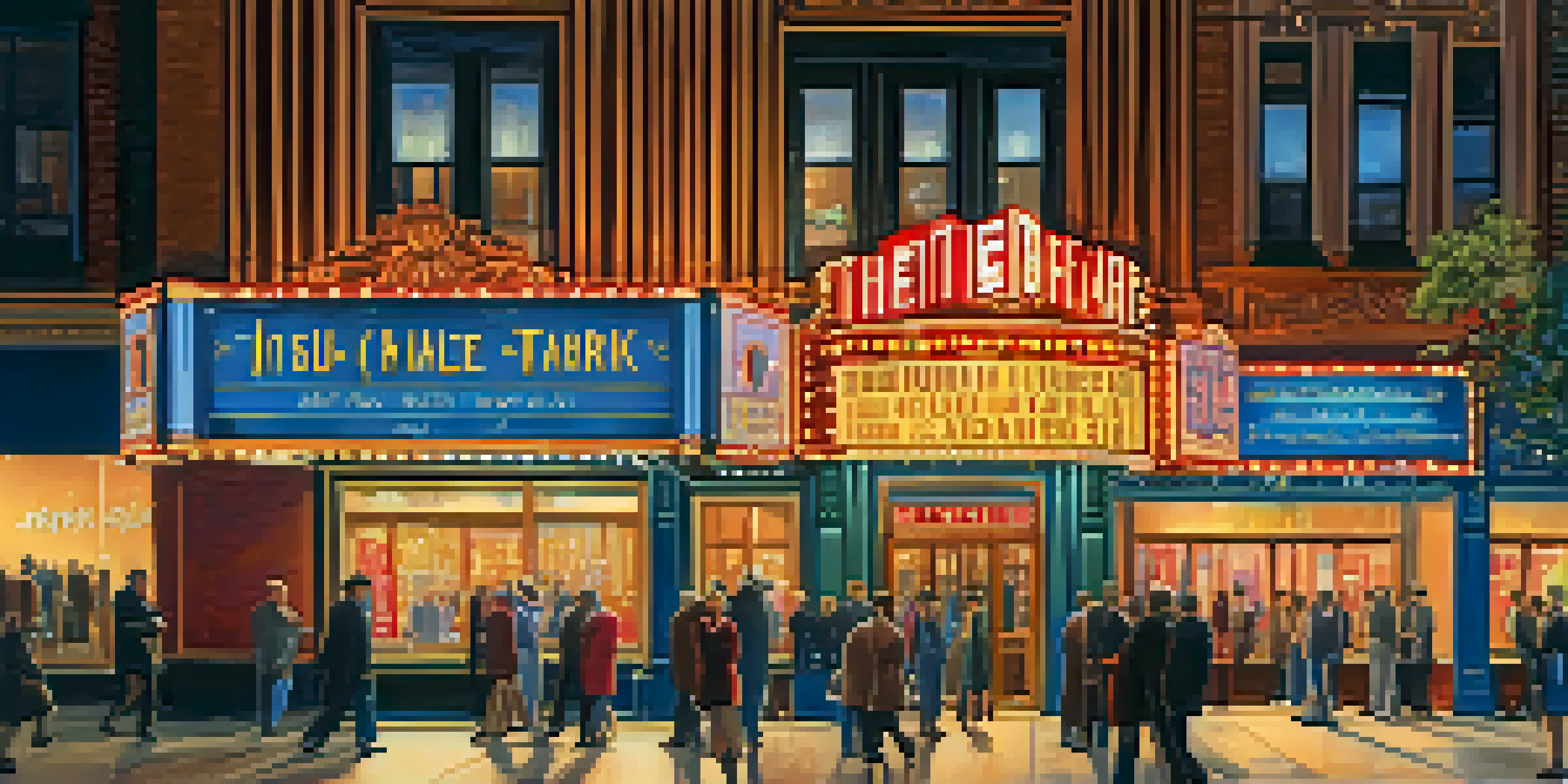The Impact of COVID-19 on the NYC Independent Theater Scene

Initial Shutdown: A Shock to the System
When COVID-19 forced New York City into lockdown, independent theaters faced an unprecedented crisis. Many small venues, already operating on tight budgets, found themselves unable to produce shows, leading to immediate financial strain. The vibrant, bustling atmosphere that characterized these theaters was suddenly silenced, leaving artists and audiences in shock.
The theater is a place where we can share our humanity, and even in times of crisis, we find ways to connect with one another.
In the early days of the pandemic, with health guidelines evolving rapidly, many theaters were forced to cancel or postpone their productions. This not only affected their revenue but also disrupted the creative process, causing projects to stall and plans to be indefinitely shelved. The uncertainty of reopening added to the anxiety felt by both theater owners and performers alike.
As days turned into weeks and weeks into months, the reality began to sink in—many theaters might not survive without immediate support. This crisis prompted urgent discussions about the future of independent theater in NYC, as stakeholders scrambled to find solutions amid the chaos.
Digital Pivot: Creativity in Crisis
With physical spaces closed, many independent theaters turned to digital platforms as a lifeline. Streaming performances and virtual events became a new norm, allowing artists to connect with audiences in unique ways. This shift not only preserved some level of engagement but also opened doors to innovative storytelling methods.

For instance, theaters that once thrived on intimate, in-person experiences began exploring interactive online performances. These adaptations allowed for a broader reach, enabling audiences from different parts of the world to participate. However, the transition to digital was not without its challenges, as technical issues and varying audience experiences often complicated the process.
Independent Theater Faces Crisis
COVID-19 lockdowns severely impacted New York's independent theaters, leading to financial strain and uncertainty about their future.
Despite the hurdles, this digital pivot showcased the resilience and adaptability of the independent theater community. It sparked a new wave of creativity, with artists finding ways to experiment and push boundaries, even in a virtual format.
Financial Struggles: The Economic Toll
The financial impact of the pandemic on independent theaters has been staggering. Many organizations faced significant losses, leading to staff layoffs and budget cuts. With ticket sales plummeting and grant funding uncertain, theaters had to make difficult decisions to ensure their survival.
Art is a collaboration between God and the artist, and the less the artist does the better.
Fundraising efforts became more crucial than ever, with theaters reaching out to their communities for support. Crowdfunding campaigns and virtual benefit performances were organized, highlighting the importance of community in sustaining these cultural institutions. Yet, the reliance on donations also underscored a troubling vulnerability within the independent theater ecosystem.
Moreover, the pandemic revealed the disparities in funding and resources among different theaters. While some managed to secure emergency grants, others struggled to navigate the complex landscape of financial assistance, raising questions about equity and sustainability in the arts.
Community Support: A Silver Lining
Amid the challenges, the pandemic also sparked a remarkable sense of community within the independent theater scene. Artists, audiences, and supporters rallied together, creating initiatives to help struggling theaters. This solidarity was a testament to the deep bonds formed through shared experiences in the arts.
Various organizations emerged to provide resources and aid, offering workshops, mental health support, and financial guidance to theater professionals. These efforts not only helped individuals navigate the crisis but also fostered a spirit of collaboration that transcended traditional boundaries. The sense of unity became a beacon of hope during dark times.
Digital Shift Sparks Innovation
Theaters adapted to the pandemic by embracing digital platforms, allowing for innovative performances and broader audience engagement.
As theaters began to slowly reopen, this strengthened community dynamic played a crucial role in their recovery. Audiences returned not just for the performances but also to support the spaces that had been vital to their cultural lives.
Innovative Collaborations: New Partnerships
The pandemic prompted many independent theaters to seek innovative collaborations as a means of survival. This included partnerships with other arts organizations, local businesses, and digital platforms. By pooling resources and sharing audiences, these collaborations helped theaters expand their reach and enhance their offerings.
For example, some theaters began co-producing shows with other companies, allowing them to share the financial burden while bringing diverse perspectives to their productions. Additionally, collaborations with local businesses led to unique fundraising events, such as outdoor performances in local parks or pop-up events in unexpected spaces.
These new partnerships not only helped theaters navigate the crisis but also injected fresh energy and ideas into the independent theater scene. The importance of collaboration became a key takeaway, illustrating how working together can lead to innovative solutions and greater resilience.
The Future of Independent Theater: A New Normal
As we look ahead, the independent theater scene in NYC is poised to enter a 'new normal.' The lessons learned during the pandemic have prompted theaters to rethink their strategies and embrace a more hybrid approach to performance. This could mean a blend of in-person and digital offerings, allowing for greater flexibility and accessibility.
The desire for connection remains strong, and audiences are eager to return to live performances. However, theaters are also recognizing the potential of digital platforms to reach wider audiences and engage with those who may not be able to attend in person. This dual approach could redefine the way theater is experienced and appreciated.
Community Unity Fuels Recovery
Amid the challenges, a strong sense of community emerged, with artists and audiences collaborating to support struggling theaters.
Ultimately, the pandemic has highlighted the resilience of the independent theater community. While challenges remain, there is a renewed sense of purpose and creativity that will likely shape the future landscape of NYC's vibrant theater scene.
Lessons Learned: Strengthening the Arts Community
The impact of COVID-19 on NYC's independent theater scene has been profound, offering valuable lessons for the future. One key takeaway is the importance of adaptability; theaters that embraced change were better positioned to survive. This adaptability extends beyond technology and fundraising to include audience engagement and community involvement.
Furthermore, the pandemic illuminated the need for sustainable practices within the arts. The financial struggles faced by many theaters have sparked discussions about equity in funding and support for independent artists. As the community moves forward, it is essential to advocate for policies that safeguard the future of independent theater.

Lastly, the experience of the pandemic has strengthened the bond between artists and audiences. As theaters reopen, this connection will be vital in rebuilding and revitalizing the independent theater scene, ensuring that it remains a thriving part of New York City's cultural landscape.